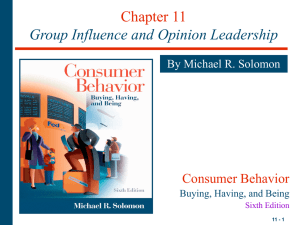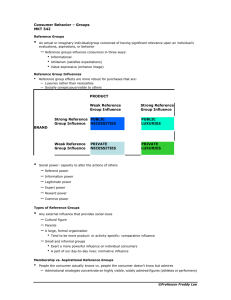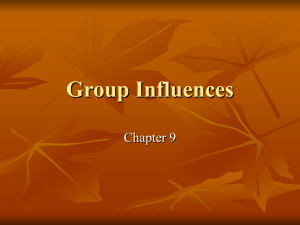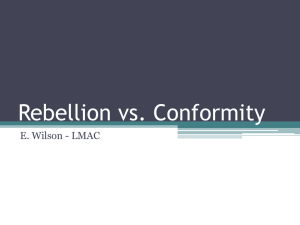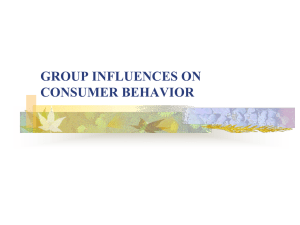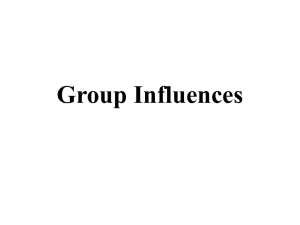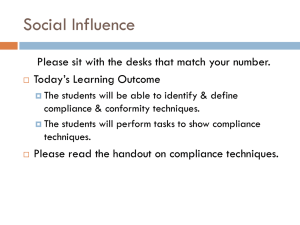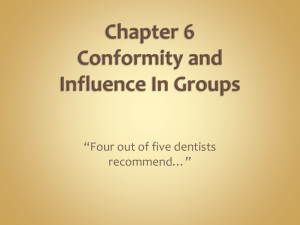Group Influence and Opinion Leadership
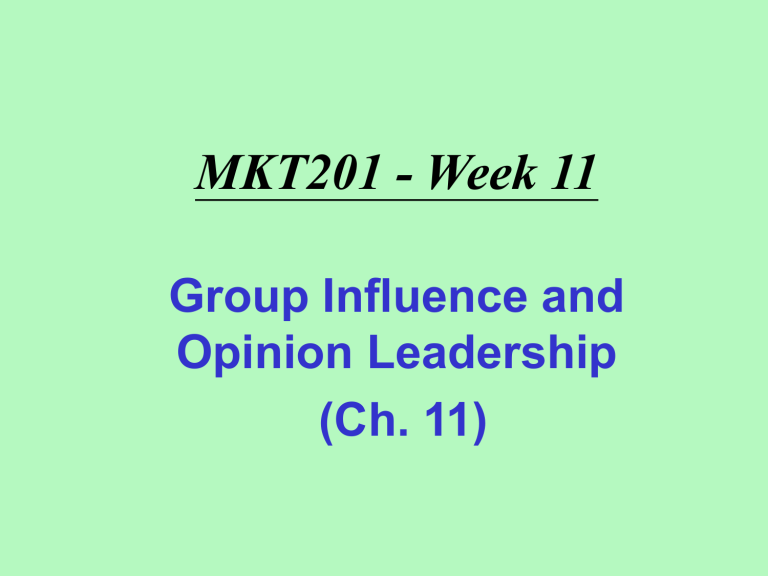
MKT201 - Week 11
Group Influence and
Opinion Leadership
(Ch. 11)
Reference Groups
• Reference Group
–
An actual or imaginary individual or group conceived of having significant relevance upon an individual’s evaluations, aspirations/intentions, or behavior
– Three ways reference groups influence consumers
1. Informational
2. Utilitarian
3. Value-Expressive
–
Some people are more influential than others in affecting consumers’ product preferences.
Reference Groups
A Reference Group is an Actual or Imaginary Individual or Group Conceived of Having Significant Relevance Upon an Individual’s Evaluations,
Aspirations, or Behavior.
Reference Groups Influence Consumers in Three
Ways/Forms:
Value-Expressive
Informational
Information, brandrelated knowledge, experts’ experience
Utilitarian
Influenced by other social/family members, etc.; as expected
Image enhancement, admired or respected by others;
Help showing as: athlete, successful person, good parents, etc.
When Reference Groups Are Important
e.g. sailboats
Luxuries
Rather Than
Necessities
A Reference
Groups Influence
Is More Powerful and Important for Purchases
That Are: e.g. living room
Socially
Conspicuous or Visible to
Others furniture, clothing
Relative Reference Groups’
Influence on Purchase Intention
(2 dimensions of the “degree of importance” of reference group: publicly/privately consumed, luxury/necessity product)
Figure 11.1
When Reference Groups
Are Important (or so Persuasive )?
• Social Power:
– The capacity to alter the actions of others
– different sources or basis of social power:
• 1. Referent Power:
–
When consumers imitate qualities by copying behaviors of a prominent person they admire .
• 2. Information Power:
–
Able to influence consumer opinion by virtue of their
(assumed) access to the “truth”
• 3. Legitimate Power:
–
Granted to people by virtue of social agreements, sometimes conferred by a uniform
When Reference Groups
Are Important (cont.)
• 4. Expert Power:
–
Derived from possessing specific knowledge about a content area
• 5. Reward Power:
–
When a person or group has the means to provide positive reinforcement
• 6. Coercive Power:
–
Influencing a person by social or physical intimidation
The Power of Reference Groups
e.g. social or physical intimidation/threat gangsters; fear appeals
Coercive
Power
SOCIAL POWER-
Capacity to alter the actions of others e.g. reward, social acceptance
– awards or medals
Reward
Power
Types of
Reference
Group
Power
Expert
Power e.g. a famous scientist, expert in Robotics
Legitimate
Power e.g. policemen, professors, doctors
Referent
Power e.g. Michael Jordan
– admired person
Information
Power e.g. Editor of a newspaper
Expert Power
• A physician has expert power, and a white coat reinforces this expertise by conferring legitimate (legal or high professional quality) power.
Types of Reference Group Influence
• Reference Group:
–
Any external influence that provides social cues
(signals)
• (1) Normative Influence:
–
The reference group helps to set and enforce fundamental standards of conduct . (e.g. parents’ influence on marriage attitude; a Photo club)
• (2) Comparative Influence:
– When decisions about specific brands or activities are affected. (e.g. Harley-Davidson club)
Discussion Question
• Marketers often portray products being used in groups that represent favorable reference groups to the target market.
• What type of message does this ad convey?
What type of influence is this ad designed to exert on its target audience?
Discussion Question
• What type of message does this ad convey?
–
Persuasive message with the use of
Reference Group’s influence
• What type of influence is this ad designed to exert on its target audience?
–
Comparative influence
Brand Communities and Tribes
• Brand Community:
–
A set of consumers who share a set of social relationships based upon usage or interest in a product.
(don’t necessary live near each other)
•
E.g. Brandfests (e.g. organized events sponsored by Nike)
• Consumer Tribe:
–
A group of people who share a lifestyle and who can identify with each other because of a shared allegiance
(loyalty) to an activity or product (such as skateboarding, basketball, car driving)
• Tribal Marketing:
– To link one’s product to the needs of a group as a whole.
(e.g. Mini Cooper, Mustang – car racing)
Products as a Way to be Popular
• Many products, especially those targeted to young people , are often touted/promoted as a way to take the inside track to popularity. This Brazilian ad lets us know about people who don’t like a certain shoe.
Bonehead – stupid person
Membership vs. Aspirational
Reference Groups
• Aspirational Reference Groups
– Comprise idealized figures such as successful business people, athletes, or performers.
• Membership Reference Group
– Ordinary people whose consumption activities provide informational social influence . Membership are affected by several factors:
• Propinquity: Physical nearness .
• Mere Exposure: Liking persons or things simply as a result of seeing them more often ( mere exposure phenomenon )
• Group Cohesiveness: The degree to which members of a group are attracted to each other and value their group membership .
Match.com
Positive Versus Negative
Reference Groups
• Avoidance Groups
–
Groups that consumers purposely try to distance themselves from
•
Nerds (stupid, unattractive)
• Druggies (addicted to drugs)
•
Preppies (manner and dress like in traditional preparatory school)
–
The motivation to distance oneself from a negative reference group can be as powerful or more powerful than the desire to please a positive group
Positive Reference Groups
• This recruiting ad presents a compelling role model for young women contemplating a career in the armed forces.
Consumers Do it in Groups
Some Phenomena
• Deindividuation:
–
A process in which individual identities become submerged within a group.
• Social Loafing:
– People do not devote as much to a task when their contribution is part of a larger group effort
• Risky Shift:
– Group members are willing to consider riskier alternatives subsequent to group discussion
• Diffusion of Responsibility:
– As more people are involved in a decision, each individual is less accountable for the outcome
Consumers Do it in Groups (cont.)
• Value Hypothesis (to explain the increased riskiness/risky shift):
– Riskiness is a culturally valued characteristic to which individuals feel pressure to conform to attributes valued by society
• Decision Polarization:
– Whichever direction the group members were leaning toward before discussion becomes more extreme subsequent to discussion (risky choice Vs conservative choice)
• Home Shopping Parties:
– Capitalize on group pressures to increase sales (e.g.
Tupperware party)
Deindividuation
• Costumes hide our true identities and encourage deindividuation.
Home Shopping Parties
• Women at a home
Tupperware party .
Group Influences
• Group pressure often influences our clothing choices.
Group Effects on Individual
Behavior
Deindividualism e.g. behave wildly at costume parties moving toward extreme; risky conservative
Decision
Polarization devote less effort for group work
Social
Loafing
Group
Effects more purchase with one other person
Shopping
Behavior
Risky
Shift greater willingness to take risk following group discussion
Bandwagon
Effect more & more group members, more conform
Conformity
• Conformity
– A change in beliefs or actions as a reaction to real or imagined group pressure .
• Norms
– Informal rules that govern behavior (for a society to function)
• Factors Influencing the Likelihood of Conformity
– Cultural Pressures
– Fear of Deviance (resulted in punishment or sanctions)
– Commitment
• Principle of Least Interest (person/group that is least committed to staying in a relationship has the most power)
– Group Unanimity (same opinions), Size, and Expertise – as groups gain in power, compliance increases
– Susceptibility to Interpersonal Influence
• Role-relaxed consumers (those are low in susceptibility to influence of others)
Conformity
Conformity Refers to a Change in Beliefs or Actions as a Reaction to Real or Imagined Group Pressure.
Types of Social Influence
Normative
Person Conforms to Meet the Expectations of a
Person or Group.
e.g. clothing; ?? wearing masks in public (SARS)
Situation is uncertain, ambiguous
Informational
Conformity That Occurs Because the Group’s Behavior is Taken as Evidence About Reality.
e.g. mimic others’ behavior, gift-giving
Factors Affecting the Likelihood of Conformity
Cultural Pressures
Fear of Deviance
China/Japan - collectivism
As groups gain in power, compliance increases
Commitment
Group Dynamics e.g. terrorists’ willing to die
Sex Differences susceptibility to be influenced by others
Interpersonal Influences
Social Comparison
• Social Comparison Theory :
–
Asserts that people look to the behavior of others to increase the stability of their self-evaluation
–
People tend to choose co-oriented peer : a person of equivalent standing
• Resisting Conformity :
– Independence: Being oblivious (unaware of) or indifferent to the expectations of others
– Anticonformity: Defiance (opposing) of the group is the actual behavior
– Reactance: The negative emotional state that results when we are deprived of our freedom to choose
Resistance to Influence
Anticomformity
Defiance of the
Group is the
Object of Behavior
Vs.
Independence
Oblivious to
( unaware of ) what is expected by others
Reactance
Need to Preserve Freedom of
Choice; People try to Overcome a
Loss of Freedom; Negative to extremely overbearing promotions .
Discussion Question
• This ad for a video game says,
“Conformity Bytes!”, but then captions
(titles), “Join the
Revolution!” Why?
• Does this ad encourage independence or anticonformity ?
Word-of-Mouth Communication
• Word-of-Mouth ( WOM ):
–
Product information transmitted by individuals to individuals.
• Negative WOM and the Power of
Rumors:
– Negative WOM
: Consumers weigh negative info from other consumers more heavily than they do positive comments
Word-of-Mouth Communication
Much Information About Products and Services is
Actually Conveyed by Individuals on an Informal
Basis called Word-of-Mouth Communication (WOM)
Factors That Encourage WOM Are:
Person is Highly Involved With the Product
Person is Highly Knowledgeable About the Product
Person Has a Genuine Concern for Someone Else
(benevolence)
Person May be Uncertain About a Recent Purchase
Word-of-Mouth
• The U.S. Postal
Service hopes to create a buzz via word of mouth.
Rumors
• Hoaxkill.com is a Web site dedicated to tracking hoaxes/ tricks and debunking/exposing product rumors.
The Transmission of Misinformation
Figure 11.2
Cutting-Edge WOM Strategies
• Virtual Communities
–
Virtual Community of Consumption : A collection of people whose online interactions are based upon shared enthusiasm for and knowledge of a specific consumption activity.
•
Multi-user Dungeons (underground chamber)
(MUD)
•
Rooms, rings and lists (e.g. chat rooms)
•
Boards
•
Blogs (weblog)
Multi-User Dungeons
Four Types of Virtual
Community Members
• Tourists:
–
Lack strong social ties to the group
• Minglers (merger, mixer):
– Maintain strong social ties, but are not interested in the central consumption activity
• Devotees:
–
Express strong interest in the activity, but have few social attachments to the group
• Insiders:
–
Exhibit both strong social ties and strong interest in the activity
Virtual Communities
2 factors: self-centrality (dominance of activity towards self-concept); intensity of social relationship/ties
Figure 11.3
Guerrilla and Viral Marketing
• Guerrilla Marketing
–
Promotional strategies that use unconventional locations and intensive word-of-mouth campaigns to push products.
• Brand Ambassadors
• Viral Marketing
– Refers to the strategy of getting customers to sell a product on behalf of the company that creates it.
(e.g. a small ad embedded in Hot Mail)
Guerrilla Marketing Ads
• Ads painted on sidewalks are one form of guerrilla marketing.
Social Networking
• Web sites letting members post information about themselves and make contact with similar others
– Share interests, opinions, business contacts http://www.myspace.com/
MYSPACE
THEFACEBOOK.COM
http://www.facebook.com/
Opinion Leadership
• The Nature of Opinion Leadership
– Opinion Leaders: People who are knowledgeable about products and whose advice is taken seriously by others.
–
Homophily: The degree to which a pair of individuals is similar in terms of education, social status, and beliefs.
(appear to be more convincing than heterophily)
• How Influential Is an Opinion Leader?
– Generalized Opinion Leader: Somebody whose recommendations are sought for all types of purchases.
–
Monomorphic: An expert in a limited field.
– Polymorphic: An expert in many fields (in a broad domain such as electronics or fashion).
Reasons to Seek Advice from
Opinion Leaders
• Expertise
• Unbiased knowledge power
• Highly interconnected in communities
(social standing)
• Referent power/homophily
• Hands-on product experience (absorb risk)
Opinion Leaders Market Shoes
• Opinion leadership is a big factor in the marketing of athletic shoes . Many styles first become popular in the inner city and then spread by word-ofmouth.
Types of Opinion Leaders
• Innovators
–
Early purchasers
• Innovative Communicators
–
Opinion leaders who also are early purchasers
–
Opinion leaders also are likely to be opinion seekers
• The Market Maven (Expert) – a consumer category
–
Describes people who are actively involved in transmitting marketplace information of all types. (not necessarily have interests or have purchased the products)
• The Surrogate Consumer – a class of marketing intermediary
–
A person who is hired to provide input in purchase decisions.
(e.g., interior decorators, stockbrokers, college consultants)
Perspectives on the
Communications Process
(tend to be opinion seekers)
Figure 11.4
Fashion Opinion Leaders
• Fashion opinion leaders tend to be knowledgeable about clothing and highly motivated to stay on top of fashion trends.
Identifying Opinion Leaders
• Many ads intend to reach influentials rather than average consumer
– Local opinion leaders are harder to find
–
Companies try to identify influentials in order to create
WOM “ ripple effect
”
–
Exploratory studies identify characteristics of opinion leaders for promotional strategies
Identifying Opinion Leaders
• Self-designated Opinion Leaders
• Sociometric Methods
Trace Communication patterns among members of a group.
– To better understand Referral Behavior
–
Network Analysis: Focuses on communication in social systems
• Referral Network
• Tie Strength: The nature of the bond between people.
– Bridging Function (weak ties): Allows a consumer access between subgroups.
–
Cliques: Subgroups (friends or associates, etc.; sharing preferences or brand choices for various products)
Characteristics of Opinion Leaders
Are Opinion
Seekers
Innovators
Own More
Clothing With a
Broader Range of Styles
Like
Music and
Magazines
Key
Characteristics of
Opinion
Leaders
Early
Communicators
Appearance-
Conscious and
Narcissistic
Self-worship, love of oneself
Socially
Active
Revised Opinion Leadership Scale
Figure 11.5
